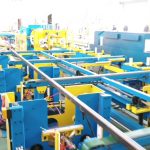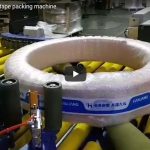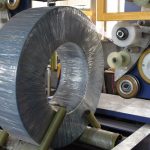The woven tape wrapping machine is for copper sheet packing with woven tape and tefflon tape.
The machine includes brush cleaning and vacuum sacker for cleaning the dust on the copper sheet before wrapping.
Automatic checking and wrapping.
Speed: 2-12m per minute.
Works for online or off line packaging.
Brush cleaning and vacuuming:
• Brush rollers scrub both sides of the copper sheet to dislodge any loose dust or debris
• A vacuum hood then suctions away the loosened particles, cleaning the sheet surfaces
• This ensures good adhesion for the subsequent wrapping tapes
Automatic checking:
• Sensors or vision systems inspect the copper sheets for defects before wrapping
• Any sheets that fail inspection are automatically rejected
• This helps ensure only conforming sheets are packed
Woven tape wrapping:
• A woven polymer or glass fiber tape is applied longitudinally along the length of the sheet
• The tape provides support and cushioning during transport and storage
• An overlap seam is formed and sealed along the length
PTFE tape wrapping:
• A layer of PTFE (Teflon) tape is applied over the woven tape layer
• The low friction PTFE tape reduces abrasion and sticking during handling
• It also acts as a moisture barrier for the wrapped sheet
Automatic operation:
• The brushing, vacuuming, checking, tape feeding and cutting operations are all automated
• Minimal manual intervention is required during operation
Speed and througput:
• Higher speed wrapping allows throughputs of 2 to 12 meters of copper sheet per minute
• The automated functions enable consistent wrapping at high speeds
Online or offline packaging:
• The wrapping machine can integrate directly into a copper sheet production line
• Or it can work offline to pack strips from storage
So in summary, the key functions of an automated woven tape wrapping operation for copper sheets include cleaning, inspection, application of woven support tape and PTFE barrier tape at consistent high speeds with minimal manual labor. This allows flexible online or offline integration.


